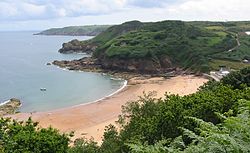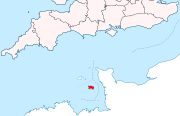Bailiwick of Jersey
| Bailiwick of Jersey (crown dependency) | |
 St Ouen | |
|---|---|

| |

| |
| Area: | 45 square miles |
| Population: | 97,857 (December 2009) |
| Capital: | St Helier |
| Time zone: | GMT |
| TLD: | .je |
The Bailiwick of Jersey is a British Crown dependency; one of the two bailiwicks of the Channel Islands. It consists of one substantial, inhabited island, Jersey, and a number of uninhabited isles and rocks, all off the coast of Normandy.
As well as the island of Jersey itself, the bailiwick includes two groups of small islands that are no longer permanently inhabited, the Minquiers and Écréhous and the Pierres de Lecq and other rocks and reefs. The island of Jersey is the largest of the Channel Islands.
The Bailiwick is not part of the United Kingdom but is a self-governing parliamentary democracy, with its own financial and legal systems. It is constitutionally entirely separate from its neighbour, the Bailiwick of Guernsey. Both have escaped membership of the European Union.
Contents
History
The history of the bailiwick is found in that of the island of Jersey. The bailiwick was created by the loss of mainland Normandy to the French in 1204, at which time Jersey and Guernsey remained loyal to King John. Repeated French attempts to invade during the unquiet ages have been repelled and the island has the fortifications which are a legacy of those times.
The island was lost to invaders in 1940: Jersey and Guernsey were taken and occupied for five hard years by the Germans after the fall of France.
After the War, the Bailiwick's autonomy produced riches: while across the industrialised world taxes rose to unprecedented levels and regulations proliferated, Jersey maintained its position. It became a tax haven and a centre for off-shore financial services.
The islands
The only island now inhabited is Jersey. The islands and islets of the Bailiwick are:
- Jersey
- Les Écréhous
- La Motte (Green Island)
- Les Minquiers
- Pierres de Lecq
- Les Dirouilles
Parishes
Jersey is divided into twelve parishes, all of which border on the sea:
- Grouville (historically Saint Martin de Grouville; incorporating Les Minquiers)
- Saint Brélade
- Saint Clément
- Saint Helier
- Saint John
- Saint Lawrence
- Saint Martin (historically Saint Martin le Vieux; incorporating Les Écréhous)
- Saint Mary
- Saint Ouen
- Saint Peter
- Saint Saviour
- Trinity
The parishes of Jersey are further divided into vingtaines (or, in St Ouen, cueillettes), divisions that are historic. Today they are used chiefly for purposes of local administration and electoral constituencies.
Government
Jersey's legislature is the States of Jersey, containing fifty-one elected members: ten senators elected in one island-wide vote, twelve Connétables (often called 'constables', heads of parishes) and twenty-nine deputies (representing constituencies). Five non-voting members are appointed by the Crown: the Bailiff, the Lieutenant Governor of Jersey, the Dean of Jersey, the Attorney General and Solicitor General.
Some government functions are carried out in the island's twelve parishes.
The Bailiff is the presiding officer of the States.[1] head of the judiciary and as civic head of the island carries out various ceremonial roles.
As one of the Crown dependencies, the Bailiwick of Jersey is autonomous and self-governing, with its own independent legal, administrative and fiscal systems.
The King's representative and adviser in the island is the Lieutenant Governor of Jersey. He is a point of contact between Jersey ministers and the United Kingdom government and carries out executive functions in relation to immigration control, deportation, naturalisation and the issue of passports.[2]
Legal system
Jersey law has been influenced by several different legal traditions, in particular Norman customary law, English common law and modern French civil law.[3] Jersey's legal system is therefore described as 'mixed' or 'pluralistic', and sources of law are in French and English languages, although since the 1950s the main working language of the legal system is English.
The principal court is the Royal Court of Jersey, from which appeals lie to the Jersey Court of Appeal and, ultimately, to the Judicial Committee of the Privy Council. The Bailiff is head of the judiciary; the Bailiff and the Deputy Bailiff are appointed by the Crown. Other members of the island's judiciary are appointed by the Bailiff.
Parish government
The Connétable is the head of each parish, elected at a public election for a four-year term to run the parish and to represent the municipality in the Assembly of the States of Jersey. The Procureur du Bien Public (two in each parish) is the legal and financial representative of the parish (elected at a public election since 2003 in accordance with the Public Elections (Amendment) (Jersey) Law 2003; formerly an Assembly of Electors of each parish elected the Procureurs in accordance with the Loi (1804) au sujet des assemblées paroissiales). A Procureur du Bien Public is elected for three years as a public trustee for the funds and property of the parish and may contract when authorised by a Parish Assembly. The Parish Assembly (Jersey)|Parish Assembly is the decision-making body of local government in each parish; it consists of all entitled voters of the parish.
Each parish elects its own force of Honorary Police consisting of Centeniers, Vingteniers and Constable's Officers. Centeniers are elected at a public election within each parish for a term of three years to undertake policing within the parish. The Centenier is the only officer authorised to charge and bail offenders. Formerly, the senior Centenier of each parish (entitled the Chef de Police) deputised for the Connétable in the States of Jersey when the Connétable was unable to attend a sitting of the States. This function has now been abolished.
Jersey is a member of the British-Irish Council.
Taxation
Until the 20th century, the States relied on indirect taxation to finance the administration of Jersey. The levying of impôts (duties) different from those of the United Kingdom was granted by Charles II and remained in the hands of the Assembly of Governor, Bailiff and Jurats until 1921 when that body's tax raising powers were transferred to the Assembly of the States, leaving the Assembly of Governor, Bailiff and Jurats to serve simply as licensing bench for the sale of alcohol. The Income Tax Law of 1928 introducing income tax was the first law drafted entirely in English. Income tax has been levied at a flat rate of 20% set by the occupying Germans during Second World War.
Because VAT has not been levied in the island, luxury goods have often been cheaper than in the United Kingdom or in France, providing an incentive for tourism from neighbouring countries. The absence of VAT has also led to the growth of industry in low-value luxury items, such as videos and lingerie are exported, avoiding VAT on arrival and thus undercutting local prices on the same items. In 2005, the States of Jersey announced limits on licences granted to non-resident companies trading in this way.
Although Jersey does not have VAT, the States of Jersey introduced a goods and services tax (GST) on 6 May 2008, at a standard rate of 3%. The rate was amended to 5% on the 1st June 2011. Some supplies are taxed at 0% and others exempt. Although GST is at 5%, shopping in Jersey is still far more expensive than in the United Kingdom and food is also not exempt unlike with VAT.
Jersey has escaped the clutches of the European Union and so is not subject to its fiscal rules nor stifling regulation.
Outside links
| ("Wikimedia Commons" has material about Bailiwick of Jersey) |
References
- ↑ States of Jersey Law 2005, Article 3 http://www.jerseylaw.je/Law/display.aspx?url=lawsinforce/htm/LawFiles/2005/l-08-2005.htm#_Toc88473878
- ↑ Office of the Lieutenant Governor. "Lieutenant-Governor". http://www.jersey.com/governmenthouse/About/Pages/default.aspx. Retrieved 22 August 2011.
- ↑ See generally S Nicolle (2009). The Origin and Development of Jersey law: an Outline Guide (5th ed.). St Helier: Jersey and Guernsey Law Review. ISBN 978-0-9557611-3-3. and "Study Guide on Jersey Legal System and Constitutional Law". Jersey: Institute of Law. http://www.lawinstitute.ac.je/default.asp?contentID=629.
Books
History
- Jersey Through the Centuries, Leslie Sinel, Jersey 1984, ISBN 0-86120-003-9
- Balleine's History of Jersey, Marguerite Syvret and Joan Stevens (1998) ISBN 1-86077-065-7
- A Biographical Dictionary of Jersey, G.R. Balleine
- The Channel Islands under Tudor Government, A.J. Eagleston
- Reformation and Society in Guernsey, D.M. Ogier
- International Politics and the Establishment of Presbytarianism in the Channel Islands: The Coutances Connection, C.S.L. Davies
- Religion, History and G.R. Balleine: The Reformation in Jersey, by J. St John Nicolle, The Pilot Magazine
- The Reformation in Jersey: The Process of Change over Two centuries, J. St John Nicolle
- The Chroniques de Jersey in the light of contemporary documents, BSJ, AJ Eagleston
- The Portrait of Richard Mabon, BSJ, Joan Stevens
Archaeology
- The Archaeology of the Channel Islands. Vol. 2: The Bailiwick of Jersey by Jacquetta Hawkes (1939)
- The Prehistoric Foundations of Europe to the Mycenean Age, 1940, C. F. C. Hawkes
- Jersey in Prehistory, Mark Patton, 1987
- The Archaeology and Early History of the Channel Islands, Heather Sebire, 2005.
- Dolmens of Jersey: A Guide, James Hibbs (1988).
- A Guide to The Dolmens of Jersey, Peter Hunt, Société Jersiaise, 1998.
- Statements in Stone: Monuments and Society in Neolithic Brittany, Mark Patton, 1993
- Hougue Bie, Mark Patton, Warwick Rodwell, Olga Finch, 1999
- The Channel Islands, An Archaeological Guide, David Johnston, 1981
- The Archaeology of the Channel Islands, Peter Johnston, 1986
Cattle
- One Hundred Years of the Royal Jersey Agricultural and Horticultural Society 1833–1933. Compiled from the Society's Records, by H.G. Shepard, Secretary
- Eric J. Boston. Jersey Cattle, 1954


